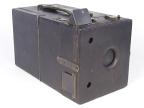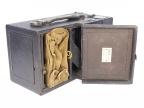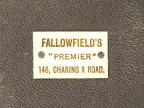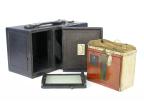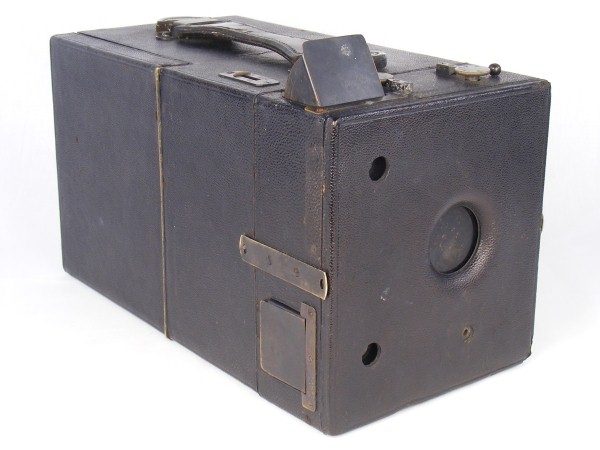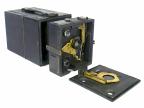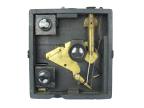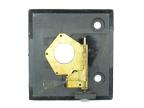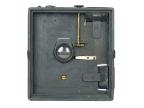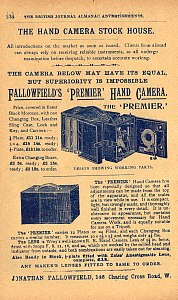Premier Hand Camera
Fallowfield
| Name: | Premier Hand Camera |
| Type: | Box Plate Camera |
| Manufacturer: | Fallowfield (but possibly made by A.S Newman) |
| Country of Origin: | United Kingdom |
| Construction: | A large wooden bodied box camera for plates, possibly originally made for plate holders but now incorporating a removable N & G changing box. Rack and pinion focussing. Two reflecting view-finders. The camera is covered in fine quality leather. |
| Production Period: | 1894 - 1900? (see Notes) |
| Plate / Film Size: | ¼ plate |
| Lens: | Wray Rapid Rectilinear f8 (2 element), F=5½IN |
| Shutter: | Sector shutter with pneumatic regulation |
| Movements: | None |
| Dimensions (w x h x l): | 13 x 14 x 25.5 cm |
| Date of this Example: | c1894 (see Notes) |
| Serial Number: | Serial / batch number 040 is marked inside rear door, inside the front panel and is also stamped into the front face of the shutter block. The lens has serial 8667 (both elements). |
| Availability: |
|
| Inventory Number: | 612 |
|
Photos copyright © 2013 David Purcell. Do not use without permission. |
Description
The Fallowfield Premier Hand camera is a large leather covered, wooden bodied box camera that bears many similarities to the N & G Universal and at the time of its introduction, would probably have been identified as a Detective camera. The shutter is a between the lens sector type, with pneumatic regulation and has a number of features in common with early shutters designed by Newman. The camera is fitted with a wide sturdy leather handle, that is similar to that fitted to some early Newman & Guardia Universal cameras.
The camera is fitted with twin viewfinders but also has a ground glass screen, with a hinged rear door to provide access to the screen for focussing. The ground glass screen is still present and is very similar to that shown on the Early Photography web site for the Universal. It possible that the camera was originally designed to be equipped with a set of DDS that could be held in the compartment at the rear of the camera. However the camera is equipped with a N & G changing box (serial 796), which is in very good condition though devoid of plate holders. The frame of the ground glass focussing screen incorporates a narrow slot that holds the slide from the changing box when removed to expose a plate. The hinged door that provides access to the plates is again reminiscent of the structure of the N & G Universal.
The camera is clearly marked as Fallowfield's "Premier" on an ivory label on the inside of the rear compartment and carries the address of "146, Charing X Road".
The camera is a focussing model with internal black square section bellows. A scale is provided adjacent to the handle showing a range from 6 feet to Infinity. The shaped bar style focusing knob appears to be identical to the form used on the Universal.
The shutter assembly can be removed as a block from the main body; two side catches hold it in place, the opposite ends of which also form the catches for the front panel, allowing that to be removed as well. The two viewfinders have metal protective covers that hinge up when the finder is in use. These are also built into the shutter block.
The shutter is of a slightly simpler form than that encountered on the N & G Universal camera, but uses similar basic principles. It is marked PATENT on the brass backing plate, but there is no evidence of a patent number.
The shutter speed and aperture are set from dials on the top of the shutter block. The speed dial operates directly on the pneumatic damper to regulate the speed with which the spring operated sector shutter travels through its arc when fired. The aperture dial is attached to a rod with a toothed wheel at the inner end that engages with a blade that has four holes, one for each aperture setting, which travel between the lenses as the dial is turned.
The following set of annotated pictures of the Premier shutter assembly describe its operation.
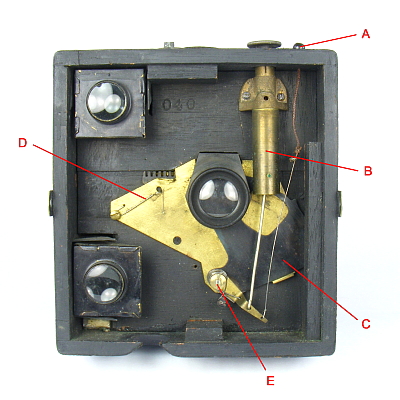 |
|
 |
Figure 1 of 4: The shutter is set by pulling on the string (A) causing the blade (C) to travel through an arc of about 60 degrees or so. A notch in the edge of the blade engages with a straight spring (D). |
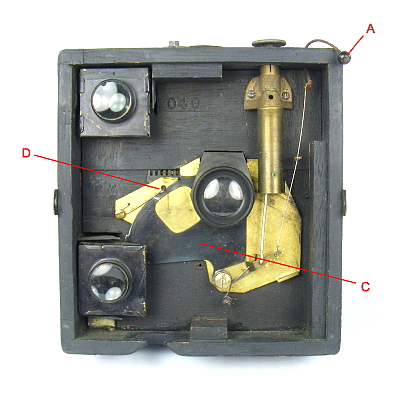 |
|
 |
Figure 2 of 4: The action of pulling on the cord (A) tensions the spring wrapped around the pivot point (E). The shutter speed is set on the dial adjacent to the pull string, which adjusts the pneumatic regulator (B). |
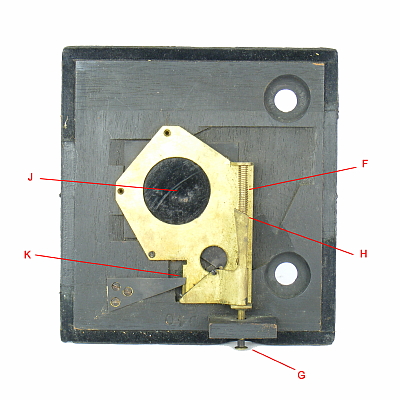 |
|
 |
Figure 3 of 4: The shutter release is built into the rear face of the removable front panel. The plunger (G) pushed against the spring (F), pushing open the lens cover (J) and at the top of its travel causes the blade (H) to dislodge the spring (D), provided that all of the parts are aligned correctly! This allows the shutter blade (C) to return through its arc and as it does so, the piston is pushed back up the damper to control the speed. |
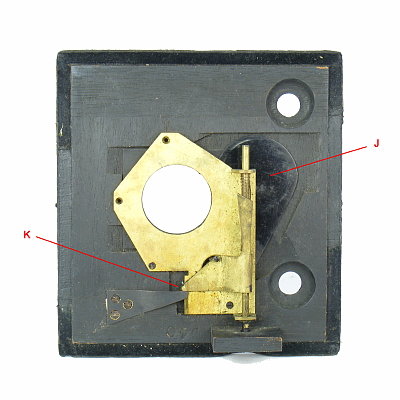 |
|
 |
Figure 4 of 4: I believe that Timed operation is achieved by pushing the plunger (G) to the end of its travel, causing the triangular section to be caught by the sprung metal clip (K), thereby leaving the shutter open. (Presumably this would also be done if using the ground glass screen for focussing.) However I am less sure how this might then be released, but note that there is a small hole in the front panel that seems to align with the gun metal sprung section. Based on on pictures of another example listed on eBay in 2016, I believe that a small flat headed pin button should be located in this hole that acts on the back of the spring clip, pushing it aside, thus allowing the mechanism to return to its normal position and the shutter to close. |
Notes
A theory put forward by another collector is that the Premier camera was designed and made while Arthur Newman was still working with Arthur Adams, but that the cameras were sold on to Fallowfield to retail after Newman's working relationship with Adams faltered. This appears plausible but as far as I know there is no firm evidence to support this story.
Antony Manthos, who has carried out detailed research into N & G cameras and written extensively on the subject in the Photographica World magazine (the premier publication of the PCCGB), notes that all examples of the Premier camera that he has encountered so far have had serial numbers less than 100. This one is marked 040. Anthony also suggests that the Premier camera fits into a sequence of developments of the Hand camera by Newman and is an early version of the design that underwent a number of adaptations thereafter as the N & G Universal.
The early patent for the shutter (19480, Nov 1890) suggests that the camera using this design might have appeared in about 1892. However the camera is not seen advertised by Fallowfield until 1896 and was apparently still available until about 1900. One possibility is that there was a delay in making the cameras available for sale.
Another possible scenario is that the cameras were made by Newman concurrently with the early N & G Universal cameras as a simpler (cheaper) design. It is interesting to note that the 1899 BJPA suggests that ¼ plate and 5 x 4 models were available from stock, while a ½ plate model was available to order. This suggests that the capability to manufacture the camera persisted throughout this period. Further, serial data available for the Wray lens fits the period when the camera was advertised by Fallowfield, although the lenses could have been fitted some time after the camera body was built. The estimated date shown for this camera is based on the lens serial number but is a best guess.
![[ ]](../../images/unchecked.png)
![[x]](../../images/checked.png)
